Answer these simple questions and we will find you the BEST prices
Which type of solar quotes do you need?
It only takes 30 seconds
100% free with no obligation

Get Free quotes from insulation specialists near you

Save money by comparing quotes and choosing the most competitive offer

The service is 100% free and with no obligation
- GreenMatch
- Insulation
- Insulation’s Impact on Condensation
How Does Insulation Impact Condensation? A UK Guide

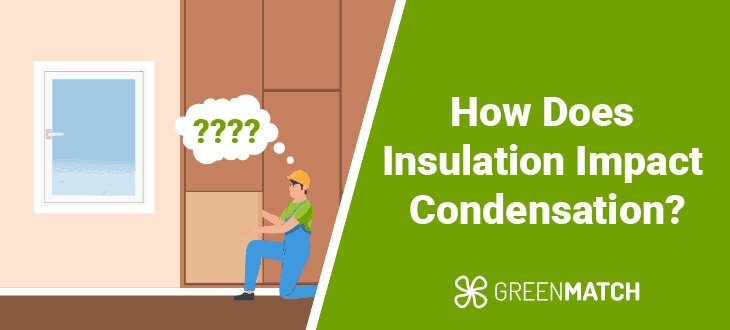
- Insulation needs to be installed properly and combined with good ventilation to prevent moisture buildup and condensation problems.
- Materials like sheep’s wool naturally regulate moisture by absorbing and releasing it, making them highly effective for preventing condensation while also being eco-friendly.
- Hiring skilled professionals guarantees proper insulation installation, reducing the risk of condensation and boosting thermal efficiency in your home.
Understanding how insulation impacts condensation is crucial for homeowners looking to create a comfortable and energy-efficient living space. Properly installed insulation helps regulate indoor temperatures, reducing the likelihood of condensation forming on cold surfaces. However, when insulation is poorly installed or inadequate ventilation, moisture can become trapped, leading to dampness, mould, and structural issues.
This guide will explore the relationship between insulation for homes and condensation, explaining how different insulation materials affect moisture control. We'll also provide practical advice on how to prevent condensation problems through proper installation and ventilation.
Whether you're planning to insulate your loft, walls, or floors, knowing how to manage condensation is critical to protecting your home and improving energy efficiency. This guide will help you make informed decisions to ensure your home remains dry, healthy, and well-insulated.
To avoid condensation issues with your insulation, it's essential to hire a professional who knows the best methods and materials. Comparing quotes helps you find a qualified specialist who can tailor the project to your needs and budget. GreenMatch offers up to four free quotes from top insulation experts in your area. Just fill out our 30-second form to get started. Click below to learn more.
- Describe your needs
- Get free quotes
- Choose the best offer
It only takes 30 seconds



Does insulation cause condensation?
Insulation itself does not cause condensation, but if it is improperly installed or lacks adequate ventilation, it can contribute to moisture build-up. Insulation condensation occurs when warm, moisture-laden air meets a cooler surface, causing the water vapour to cool and condense into liquid form.
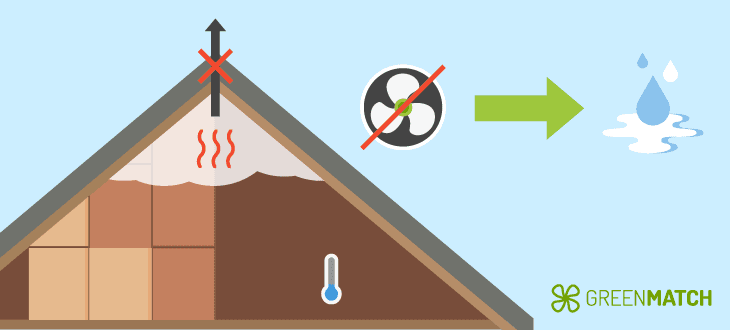
While insulation helps regulate indoor temperatures and can reduce condensation in certain areas, improper installation may exacerbate the problem. If there is insufficient ventilation or airflow, the insulation can trap moisture. For example, condensation in lofts after insulation is common when warm air from the house rises and encounters cold surfaces in the loft, leading to dampness. This issue often worsens when the insulation blocks airflow.
Similarly, cavity wall insulation damp can occur if the walls are not suitable for insulation or if moisture barriers are ineffective, allowing water to enter and become trapped within the walls. To prevent these problems, it is crucial to ensure there are proper ventilation gaps and airflow around the insulation. This careful balance between insulation and condensation management is key to avoiding issues.
Additionally, adding too much insulation may seem like a way to improve your home's thermal efficiency, but it can actually do more harm than good. Over-insulating can block essential ventilation in areas like walls and lofts, preventing airflow and trapping moisture.
When insulation material lacks moisture resistance, this can become a significant issue. If moisture infiltrates the insulation—whether from a roof leak or condensation inside the home—it can become trapped, leading to mould and mildew growth. This not only creates a musty odour but can also pose health risks to those living in the space. Proper balance in insulation thickness, ventilation, and moisture control is critical to avoiding these problems.
How condensation can damage your home
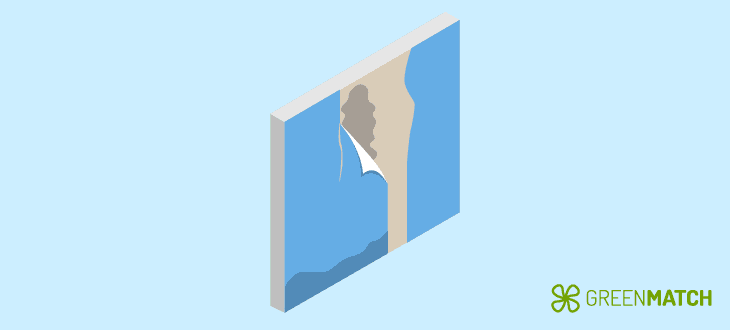
Unchecked condensation can cause significant damage to your home, leading to structural and health issues. This is especially true when insulation and condensation problems are present, as improper insulation can trap moisture and make matters worse.
Excessive moisture from condensation provides the ideal environment for mould growth, particularly in areas with poor ventilation. Mould can develop on walls, ceilings, and furniture, weakening materials over time. It also releases spores that can cause respiratory issues, allergies, and asthma, posing a health risk to occupants.
Persistent condensation leads to dampness in walls, floors, and ceilings, compromising your home's structural integrity. Insulation condensation can worsen this, causing trapped moisture to seep into building materials, resulting in rotting wood, weakened plaster, and deterioration.
Additionally, condensation can damage your home's aesthetics. Moisture buildup can cause wallpaper to peel, bubble, or stain, and paint to crack or discolour. These issues may require costly and frequent repairs.
To avoid insulation and condensation problems, it's crucial to enlist the expertise of skilled professionals who can adeptly address insulation and ventilation issues. At GreenMatch, we provide up to four complimentary quotes from leading insulation specialists in your area. Complete our brief 30-second form to access your quotes. Click below to take the first step!
- Describe your needs
- Get free quotes
- Choose the best offer
It only takes 30 seconds



How does insulation stop condensation?
Insulation plays a vital role in preventing condensation by regulating the temperature of surfaces within your home. Condensation occurs when warm, moisture-filled air comes into contact with cooler surfaces, causing the moisture to condense into water droplets. Insulation helps by keeping the temperature of walls, ceilings, and floors closer to the ambient air temperature, reducing the likelihood of moisture forming.
Here is how insulation helps prevent condensation:
- Regulates temperature: One of the primary ways insulation prevents condensation is by regulating the temperature of the interior surfaces. Insulation acts as a barrier that reduces heat transfer between the inside and outside of your home. This prevents walls and ceilings from getting too cold, which is a major cause of condensation. For example, in roof space insulation, keeping the loft area well-insulated prevents cold spots from forming in your roof, which can otherwise attract condensation.
- Reduces cold spots: Properly installed insulation helps eliminate cold spots throughout your home, especially in areas prone to moisture build-up, such as around windows or in loft spaces. Insulating all areas minimises the chances of cold surfaces forming, effectively reducing condensation.
- Improves energy efficiency: Insulation helps keep your home warmer without needing to rely as much on heating systems, which can reduce energy consumption. By maintaining a more consistent temperature, insulation prevents the conditions that lead to condensation—such as sudden drops in surface temperatures—which ultimately helps reduce moisture build-up.
By improving thermal regulation and reducing cold surfaces, insulation effectively minimises condensation, creating a drier, healthier home.
Best insulation types to prevent condensation
Selecting the right type of insulation is critical to preventing condensation in your home. Proper insulation helps regulate indoor temperatures and minimises the chances of moisture buildup, which can lead to condensation.
Beyond managing insulation and condensation, it’s essential to factor in your budget, the areas of your home you plan to insulate, and the use of sustainable materials. It is also crucial to ensure that each material is installed at its recommended thickness. This not only improves thermal efficiency but also prevents cold spots, which are prone to condensation. Here are the best insulation types to prevent condensation and how they work:
Fibreglass
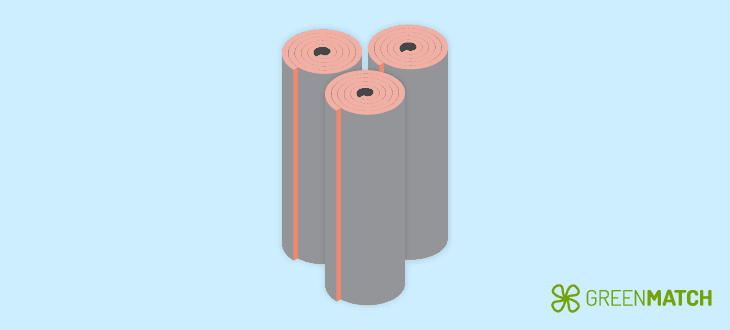
Fibreglass is one of the most affordable loft and internal wall insulation materials. It slows heat transfer, helping reduce surface temperature drops and minimising condensation. However, fibreglass is not suitable for external wall insulation because it tends to absorb and retain moisture. In external walls, where exposure to moisture is higher, fibreglass can become saturated if condensation forms, leading to water retention. This can result in the growth of mould and mildew, which not only compromises the insulation's effectiveness but poses health risks.
Moreover, fibreglass does not create an airtight seal, making it less effective at preventing condensation from penetrating the material in external walls. For this reason, a vapour barrier is essential when installing fibreglass to help protect against moisture build-up. Fibreglass can work well when properly installed in internal spaces. However, it is not the best choice for external walls, where more moisture-resistant materials like rigid foam boards or spray foam are better suited to prevent condensation.
If you're budget-conscious and planning to use fibreglass in internal areas, ensuring proper installation with a vapour barrier will help prevent condensation-related issues. For external walls, opting for materials specifically designed to resist moisture and condensation build-up is recommended
Mineral wool

Mineral wool is one of the best insulation materials for preventing condensation due to its high breathability and moisture resistance. This material allows moisture to pass through without becoming trapped, making it ideal for internal and external walls and loft insulation. Its breathability helps ensure condensation does not accumulate within walls or roof spaces, reducing the risk of dampness and mould. Additionally, mineral wool is naturally water-resistant and fire-resistant, providing added protection for your home.
Mineral wool is particularly beneficial in areas like lofts and walls where proper airflow and moisture control are critical. Allowing moisture to escape instead of being absorbed helps keep structures dry and prevents condensation from causing damage. This makes it a preferred choice for spaces prone to humidity or temperature fluctuations, as it works effectively to regulate moisture and avoid condensation buildup.
However, there are a few potential downsides when using mineral wool. One of the main concerns is its density and weight, which can add extra load to walls and roofs, especially in older homes with weaker structures. If your home cannot support this additional weight, it could lead to structural issues.
Sheep wool

Sheep's wool is an excellent eco-friendly insulation option, offering natural thermal regulation and moisture management properties that make it suitable for all areas of your home, including walls, lofts, floors, and roofs. Its ability to absorb and release moisture without losing its insulating effectiveness helps reduce the risk of condensation across these spaces.
Unlike synthetic materials, sheep's wool can hold up to 35% of its weight in moisture, making it effective at regulating humidity levels and preventing moisture buildup. This natural insulation option is ideal for maintaining a balanced indoor climate throughout your home.
However, while sheep's wool performs well in moisture management, it requires proper ventilation to prevent potential dampness or musty odours if it becomes overly saturated. Additionally, it tends to be more expensive than other materials, which may only fit some budgets. Despite this, it remains one of the most sustainable and effective options for insulation and condensation control when paired with good airflow.
Rigid foam boards
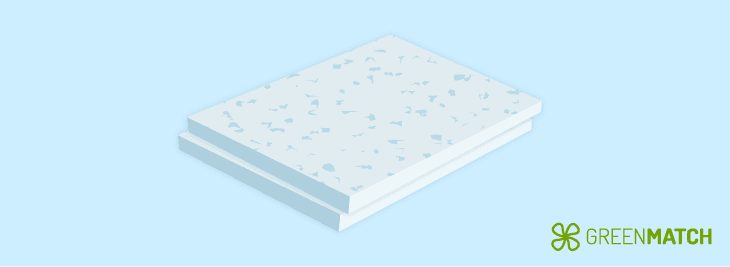
Rigid foam boards, such as polystyrene and polyurethane, are highly effective at preventing condensation due to their strong thermal resistance and moisture control properties. These boards create a solid barrier that helps maintain surface temperatures, reducing the likelihood of condensation forming when warm, humid air meets cold surfaces. Because they are impermeable to water, they do not absorb moisture, making them ideal for areas prone to high humidity or moisture exposure, such as basements, external walls, and roofs.
Rigid foam boards, including walls, floors, and roofs, suit many home areas. Still, they are especially effective in locations where insulation must provide thermal resistance and moisture protection. However, potential risks arise if the boards are not correctly installed.
Gaps between the boards and the wall structure can allow air and moisture to seep in, creating cold spots where condensation may form. Additionally, rigid foam boards should be paired with proper ventilation, as over-sealing can trap moisture inside the building, leading to condensation buildup behind the insulation.
In summary, rigid foam boards are highly suitable for preventing condensation in most home areas as long as they are installed correctly and paired with adequate ventilation.
Spray foam

Spray foam insulation is highly effective at preventing condensation because it creates an airtight and moisture-resistant barrier. When applied, spray foam expands to fill gaps, cracks, and hard-to-reach areas, forming a seamless layer that helps maintain consistent surface temperatures and prevents warm, humid air from coming into contact with cooler surfaces—one of the leading causes of condensation. This makes spray foam particularly suitable for areas where air leakage is common, such as roofs, lofts, and wall cavities.
Spray foam is versatile and can be used in various parts of the home, including walls, attics, and floors. However, potential risks arise if it is over-applied or improperly installed. Because spray foam creates such an airtight seal, inadequate ventilation can trap moisture inside the structure, which may result in condensation buildup within the walls or loft spaces. Additionally, improper installation or failure to account for ventilation needs can cause moisture problems, mould growth, or dampness over time.
In conclusion, spray foam is highly effective for preventing condensation and is suitable for many areas of the home. However, it must be installed carefully, ensuring proper ventilation is maintained to avoid trapping moisture, possibly leading to condensation issues.
How to avoid condensation issues when installing insulation
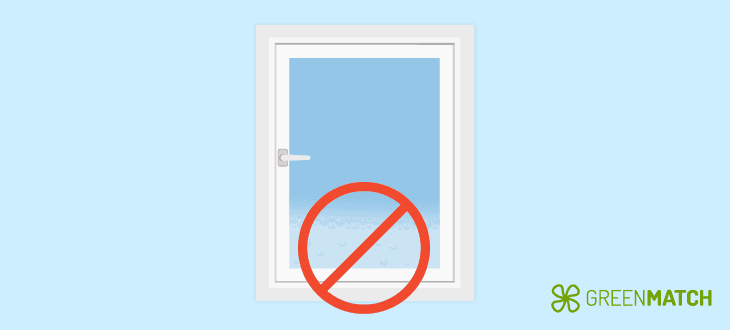
To avoid condensation issues when installing insulation, working with experienced professionals who understand the complexities of insulation and moisture management is essential. Proper installation is crucial in preventing condensation, leading to problems like dampness, mould growth, and structural damage. Professionals are equipped to assess your home’s specific needs, ensuring the right type of insulation is used and installed at the correct thickness to regulate temperature and minimise the risk of moisture buildup.
Experts also ensure that insulation is paired with adequate ventilation, which prevents condensation. Poorly installed insulation can block airflow, trap moisture, and create cold spots, increasing the risk of condensation. Professionals know how to balance insulation and ventilation to maintain a healthy indoor environment while enhancing energy efficiency.
Hiring experts will save you from costly mistakes and future repairs. They will also ensure that vapour barriers and other necessary moisture controls are correctly installed, reducing the risk of condensation-related issues. For peace of mind and a well-insulated home, it’s always best to work with qualified insulation specialists.
Finding the right professionals to install insulation for maximum thermal efficiency and condensation prevention can be time-consuming, as it requires comparing multiple quotes to suit your budget and preferences. Fortunately, GreenMatch simplifies this process by offering up to four free quotes from top installers in your area. Just fill out our 30-second form to receive these quotes, with no obligation to accept and no hidden costs. Click below to learn more.
- Describe your needs
- Get free quotes
- Choose the best offer
It only takes 30 seconds



FAQ
Spray foam, mineral wool, rigid foam boards and sheep’s wool are among the best insulation types to stop condensation by regulating surface temperatures and preventing moisture build-up.
Yes, condensation can result from poorly installed insulation. While insulation itself doesn’t cause condensation, improper installation—such as blocking airflow or applying it too closely to roof or wall surfaces—can lead to moisture build-up.
Yes, too much loft insulation can block ventilation, limiting airflow and leading to condensation.
To stop condensation running down walls, improve ventilation and add insulation to regulate surface temperatures and reduce moisture build-up.

Caoimhe is an experienced content writer and researcher who is passionate about providing accessible information to every reader. With a background in English literature and Sociology, she combines the two disciplines to create cohesive, well-thought-out, and well-informed pieces.
We strive to connect our customers with the right product and supplier. Would you like to be part of GreenMatch?

- Describe your needs
- Get free quotes
- Choose the best offer
It only takes 30 seconds



